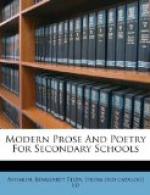The immense bonfires where fifty or a hundred cords of peeled, split, smashed wood has been piled around some old giant by a single stroke of lightning is another grand sight in the night. The light is so great I found I could read common print three hundred yards from them, and the illumination of the circle of onlooking trees is indescribably impressive. Other big fires, roaring and booming like waterfalls, were blazing on the upper sides of trees on hillslopes, against which limbs broken off by heavy snow had rolled, while branches high overhead, tossed and shaken by the ascending air current, seemed to be writhing in pain. Perhaps the most startling phenomenon of all was the quick death of childlike Sequoias only a century or two of age. In the midst of the other comparatively slow and steady fire work one of these tall, beautiful saplings, leafy and branchy, would be seen blazing up suddenly, all in one heaving, booming, passionate flame reaching from the ground to the top of the tree, and fifty to a hundred feet or more above it, with a smoke column bending forward and streaming away on the upper, free-flowing wind. To burn these green trees a strong fire of dry wood beneath them is required, to send up a current of air hot enough to distill inflammable gases from the leaves and sprays; then instead of the lower limbs gradually catching fire and igniting the next and the next in succession, the whole tree seems to explode almost simultaneously, and with awful roaring and throbbing a round, tapering flame shoots up two or three hundred feet, and in a second or two is quenched, leaving the green spire a black, dead mast, bristled and roughened with down-curling boughs. Nearly all the trees that have been burned down are lying with their heads up hill, because they are burned far more deeply on the upper side, on account of broken limbs rolling down against them to make hot fires, while only leaves and twigs accumulate on the lower side and are quickly consumed without injury to the tree. But green, resinless Sequoia wood burns very slowly, and many successive fires are required to burn down a large tree. Fires can run only at intervals of several years, and when the ordinary amount of fire-wood that has rolled against the gigantic trunk is consumed, only a shallow scar is made, which is slowly deepened by recurring fires until far beyond the centre of gravity, and when at last the tree falls, it of course falls up hill. The healing folds of wood layers on some of the deeply burned trees show that centuries have elapsed since the last wounds were made.
When a great Sequoia falls, its head is smashed into fragments about as small as those made by lightning, which are mostly devoured by the first running, hunting fire that finds them, while the trunk is slowly wasted away by centuries of fire and weather. One of the most interesting fire-actions on the trunk is the boring of those great tunnel-like hollows through which horsemen may gallop. All of these famous




